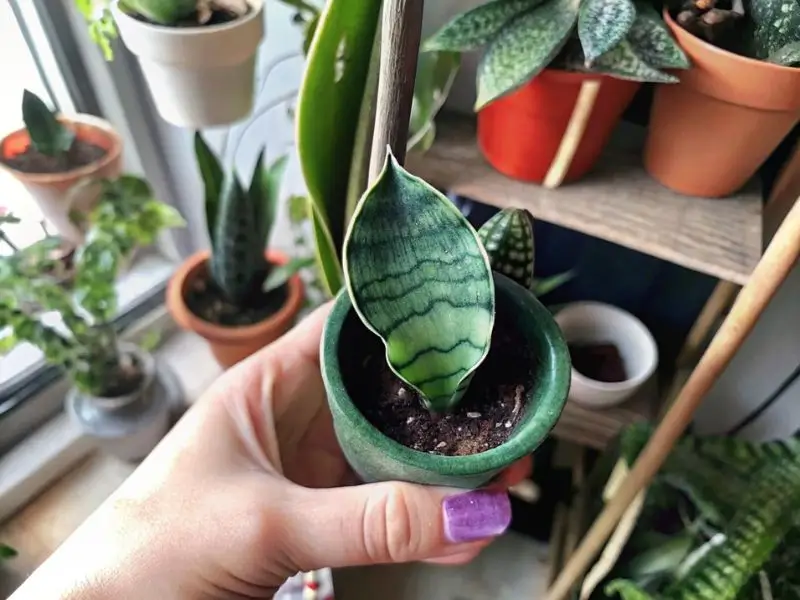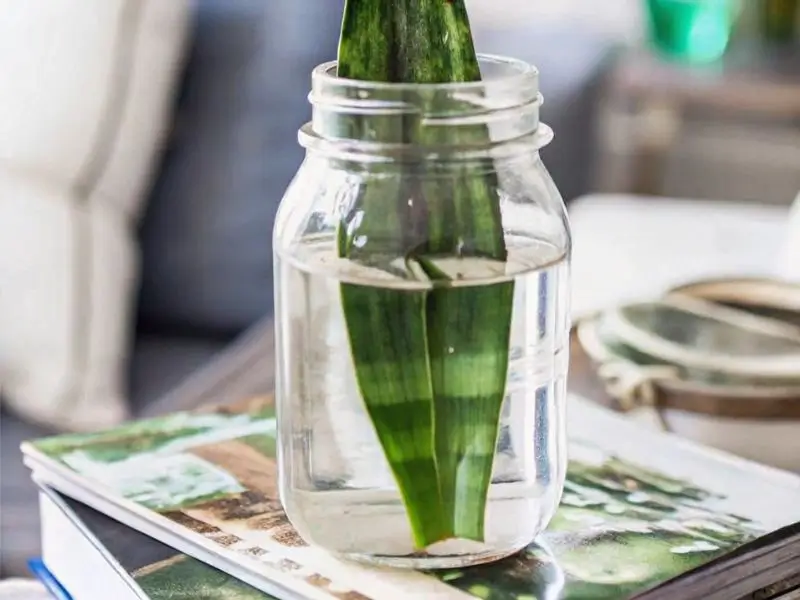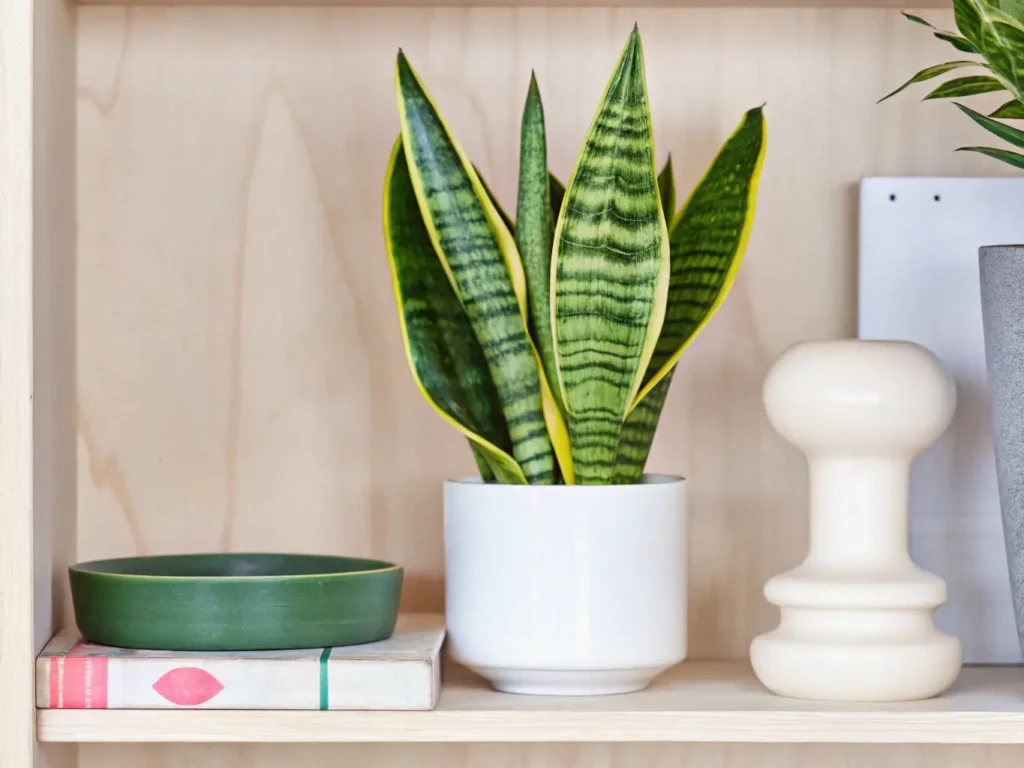
In This Article
Snake Plant, also called “Mother-in-Law’s Tongue,” is botanically known as Sansevieria trifasciata. It’s best known for its tall, upright leaves that add a bold, structural touch to any room. Growing at a moderate pace, the snake plant generally reaches about two to four feet. It thrives in bright, indirect light but can also handle lower light spots, making it ideal for beginners. Watering is delightfully easy—just water sparingly and let the soil dry between drinks.
If you have pets, be mindful that the leaves contain mild toxins. Overall, this houseplant’s sleek, vertical foliage makes it a standout choice for those who want a fuss-free, eye-catching addition to their indoor space.
Snake Plant Care
If you’re short on time or prone to forgetting your watering schedule, this plant can be your new best friend. The snake plant thrives on the principle of “less is more,” which means overwatering or excessive care can actually do more harm than good.
Light
Although bright, indirect light brings out its vibrant leaf patterns, this hardy greenery can stay healthy in low-light corners. If you have a sunny windowsill that receives morning rays, it should do just fine there. Sometimes, direct afternoon sun can scorch the tips, so a filtered curtain might help if the sun’s too strong.
Water
Here’s the easiest rule: let the top one or two inches of soil dry out before giving another drink. In summer, you might water every couple of weeks. In winter, stretch it to three or four weeks. Snake plants can rot if they’re kept constantly moist, so be patient with watering. If you’re unsure, wait another day or two. They’d rather be parched than soggy.
Soil
This plant is part of the succulent family, so choose a fast-draining mix. A standard cactus or succulent blend usually contains porous materials like perlite or coarse sand. If you only have basic potting soil, you can mix in about one-third sand or perlite to help water escape more quickly.
Temperature & Humidity
Average indoor temps between 65 and 85°F (18–29°C) keep snake plants in their comfort zone. They aren’t fussy about humidity, so no need to add a humidifier or mist the leaves. Just avoid extremely cold drafts, since that may damage your plant over time.
Fertilizer
Feeding once every two or three months during spring and summer is plenty. A balanced, diluted houseplant fertilizer works well. Overfeeding can lead to soft or distorted leaves, so it’s best to go light on this step.For a similarly easy-care option, check out Spider Plant Care. You’ll find that spider plants share the same unfussy attitude.If you want official details about broader plant care, you can also see resources from the United States Department of Agriculture. Where they discuss plant hardiness zones and other gardening tips.
Snake Plant Varieties

Snake plants come in several gorgeous varieties. Each has a distinct flair, so you can pick one that suits your style or start collecting a mini jungle of them.
Sansevieria trifasciata ‘Laurentii’
This fan-favorite features tall, pointed leaves edged in bright yellow. The center is often layered with bands of darker and lighter greens, giving it a striped effect.
Sansevieria trifasciata ‘Zeylanica’
Similar shape to ‘Laurentii,’ but with more subdued, wavy markings across dark green leaves. It sometimes looks less flashy but remains just as hearty.
Sansevieria hahnii (Bird’s Nest Snake Plant)
Perfect for tight spaces. This one grows in small rosettes, staying around eight to ten inches tall. Its short, wide leaves pack a similar pattern in a tiny footprint.
Sansevieria cylindrica
Leaves are cylindrical and stand upright like slender rods. If you’re after a sculptural, modern look, this variety might become your new centerpiece.
Sansevieria trifasciata ‘Moonshine’
Sporting silvery-green leaves, ‘Moonshine’ has a pale, almost ghostly color. If your décor leans toward cooler palettes, this might be the ideal companion.
There are more cultivars out there, some rarer than others, with different leaf shapes and color undertones. No matter which variety you select, they all share the same easy-care nature and a knack for surviving even if you occasionally forget the watering can.
Pruning
Pruning a snake plant is not an everyday chore, but it can help keep your plant looking sharp. The neat, upright growth habit often means less maintenance, yet a few strategic trims here and there can remove damaged or aging leaves.
When Should You Prune?
Anytime you spot leaves turning yellow, brown, or limp, it’s time to get the scissors out. Overwatering or physical damage may cause leaves to become unsightly, so removing them pronto gives the plant room to channel energy into healthier foliage.
Tools and Technique
A clean pair of shears or gardening scissors is best. Make your cut near the base of the leaf, but be careful not to harm adjacent leaves or the root area. Some snake plants form clumps, so make sure you’re trimming just the leaf that’s causing trouble.
Benefits
Aside from improving the plant’s appearance, pruning a snake plant reduces the chance of disease or pests finding a home in rotting material. It also encourages any new baby shoots or pups to grow more vigorously, since the plant won’t be wasting energy on declining leaves.
Aesthetic Shaping
You might see leaves leaning or flopping if they’ve been in very low light, so feel free to remove those if they’re significantly bent or damaged. There’s no need to overdo it, though, snake plants naturally stand tall, so they’re quite good at keeping themselves in a tidy shape.
Propagating Snake Plant
Propagating your snake plant is a fun way to multiply your collection. You can gift these extra plants to friends or spread them around various rooms at home.
Division Method

If your snake plant pot is crowded with multiple leaf clusters, gently pull the entire plant from the container. Notice separate root clumps and rhizomes. Carefully loosen them, being mindful not to tear roots too aggressively. Once separated, place each clump into its own pot with fresh soil. This route gives you “grown-up” pieces right away, so your new plants look almost like mini versions of your original.
Leaf Cuttings in Water

Clip a sturdy, healthy leaf near the base. Cut it into sections that are three to four inches long. Position each piece upright in a jar of water. Keep it where it can get some indirect sunlight. Replace the water weekly so it stays fresh. Over a few weeks, you’ll see tiny roots sprout—this is your signal that it’s ready for potting.
Leaf Cuttings in Soil
Similar to the water method, but skip the jars and plant each leaf cutting directly into a fast-draining mix. Some people dip the cut end in rooting hormone powder, though it’s optional. Keep the soil lightly moist so roots can develop. If conditions are just right, new pups will appear at the base, much to your delight.One interesting houseplant you might enjoy is the Black Dragon Plant. It’s another showstopper that can spark conversation among fellow plant lovers.
Potting and Repotting Snake Plant

Potting and repotting your snake plant is quite straightforward and helps keep roots from getting cramped. While these plants don’t mind slightly snug quarters, there comes a time when an upgrade works wonders.
Container Choices
Terra cotta pots are popular because they let extra moisture evaporate through the sides. This helps guard against overwatering. Plastic pots are okay too, but they trap more moisture, so you may need to water less frequently. Always choose a pot with a drainage hole so water can flow out.
Soil Requirements
For a snake plant, stick to a gritty, free-draining mix. A succulent or cactus soil blend is an easy pick. If you have average potting soil, just blend in one-third perlite or coarse sand. The key is preventing puddles around the roots.
When to Repot
Most people repot every two or three years, or when the roots start poking out the bottom. Spring is a convenient time because the plant is generally more active then. If the topgrowth looks crowded or you can see roots circling inside, it’s a sure sign the plant wants some space.
Repotting Steps
- Loosen the root ball and gently lift your plant from its old pot.
- Remove any rotten or dried roots.
- Position the plant in its new pot, adding fresh soil around the edges.
- Water lightly to settle the mix, then wait until the top layer dries before watering again.
Providing just an extra inch or two of pot diameter is enough. Overly large pots can lead to excessive soil moisture and raise the chance of root rot.
Common Pests and Diseases
Snake plants tend to be tough, but some pests and diseases can still pester them. Keep your eyes peeled for early signs of trouble.
Troublesome Pests
- Mealybugs often appear as cottony clumps. They suck sap from leaves, weakening the plant over time.
- Spider Mites are tiny and may leave a faint webbing or speckling on leaves. Dry, indoor air can encourage them.
- Thrips leave silvery or streaky patterns on leaf surfaces. They can distort new growth if left unmanaged.
Wiping the leaves with a slightly damp cloth can physically remove some insects. If infestations get worse, apply a gentle insecticidal soap or neem oil spray. Repeat until you see no new pests.
Disease Issues
- Root Rot is typically the most common. It arises from overwatering or poorly draining soil. You might see yellow, drooping leaves and detect a foul smell. If that happens, trim off rotted roots and repot in fresh, well-draining mix.
- Leaf Spot can come from fungal or bacterial issues. It often shows up as small, brown or reddish spots on foliage. Keep the leaves dry and prune off affected parts to limit its spread.
Regular checks help you tackle minor problems before they become major headaches. If needed, move the plant away from others to prevent pest migration while fixing the issue.
Common Issues With Snake Plant
Even a hardy houseplant can run into issues. Here are a few stumbling blocks and how to address them.
Yellow Leaves
Too much water is often the culprit. Snake plants don’t like soggy feet. Wait until the top inch or two of soil feels dry to the touch before you water again. Prune off the yellow leaves at the base.
Drooping or Curling Leaves
If your snake plant shows drooping or curling leaves, it could be reacting to sudden temperature shifts or serious underwatering. Make sure your indoor climate stays fairly stable. Give the plant a thorough drink if the soil is bone-dry, but then let it drain well.
Brown Leaf Tips
Minor browning at the leaf tips can happen when humidity is extremely low. Although snake plants generally don’t mind dryness, severe lack of moisture can cause crispy edges. Inconsistent watering might also be to blame.
Mushy Stems or Bases
Likely a sign of overwatering or root rot. It’s better to unpot the plant, remove rot-damaged roots, and place it in fresh soil that drains quickly. Hold back on watering until the plant recovers.
Slow or Stunted Growth
Your plant might need a bit more light or a slightly larger pot. Also, consider feeding once in a while during spring and summer if you haven’t done so. With proper care, fresh leaves will eventually appear, though snake plants are naturally slower growers compared to others.
FAQ
What does a snake plant do for your house?
It brings tall, bold foliage to your space with minimal effort. Many plant enthusiasts believe it can help with indoor air freshness, though results may vary. Mostly, it stands out as a stylish, upright centerpiece that’s easy to keep alive.
What is the disadvantage of snake plants?
Overwatering can lead to root rot, which is usually the biggest struggle. The plant also contains mild toxins that could harm pets or kids if they chew on the leaves.
Where should I put my snake plant in my house?
Place it in bright, indirect light if you can. However, it will also manage in shadier spots, just expect slower growth.
Why are snake plants toxic?
They contain natural saponins, which can upset stomachs and cause discomfort if ingested by pets or people.

12 thoughts on “Snake Plant : Easy Indoor Care Guide”
Comments are closed.